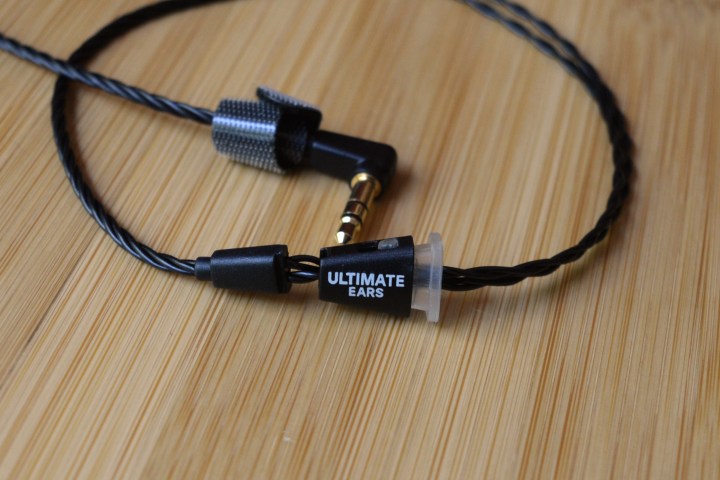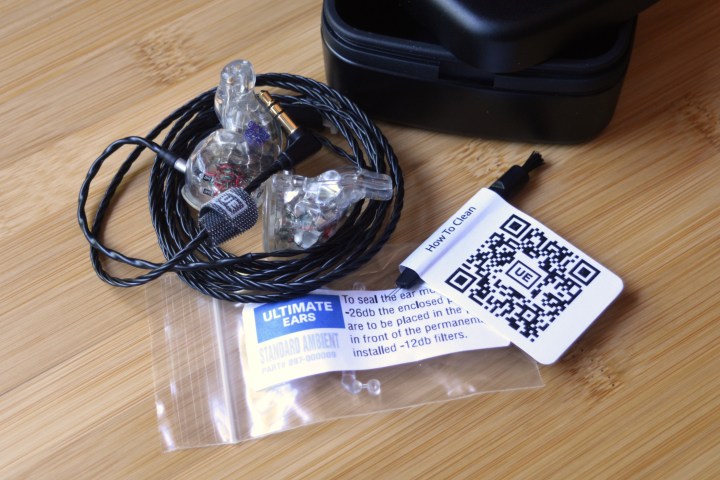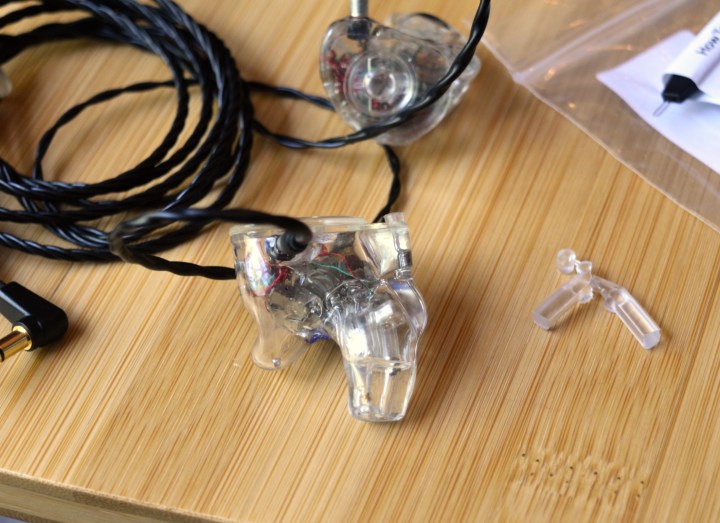
- Astonishing sound
- Custom 3D fit
- Durably built
- Lots of personalization options
- Very expensive
- Deep canal fit won't be for everyone
The thought of paying $3,000 for a set of wired earbuds is likely to raise an eyebrow, even if you’re no stranger to high-end audio gear. That’s especially the case if the earbuds in question haven’t been inlaid with precious gemstones or cast from an exotic metal alloy normally reserved for aerospace applications.
And yet that’s the starting price for Ultimate Ears Pro UE Premier, a set of clear acrylic in-ear monitors (IEMs) that justify their sky-high asking price with two key ingredients: they’re custom molded from 3D ear scans to fit your ears perfectly, and each earbud has been packed with a record-breaking 21 drivers. Yup, your math is correct — 42 drivers in total.
Knowing this, only one question remains. Can the UE Premier come even close to delivering a listening experience that matches the required investment? After spending six weeks with the Premier, I think the answer is yes, but that’s far from a recommendation. Here’s why.
UE Premier: ordering and customization

Because the Premier are custom-made (and customizable) IEMs, it’s worth discussing the ordering process. The Premier are at the top (obviously?) of an eight-product line that starts with the UE 5 Pro at $549, with prices (and specs) increasing from there until you land at the flagship UE Premier.
Using the UE Pro website, you start with the base Premier IEMs at $2,999. At this point, you have two choices: go with either the standard fixed faceplate version or UE Pro’s Switch swappable faceplate system, which adds $199, but comes with three sets of faceplates. Either way, UE Pro offers dozens of colors, textures, and graphics to choose from. Can’t find one you like? Upload your own artwork for an additional $200 and get whatever you want on your IEMs. Want a different choice for each earbud? No problem.
For my review sample, I picked the transparent “clear,” the dark wooden “ebony,” and the skull-themed “godhood,” because why not? Sadly, due to the specific shape of the Premier, if you already own UE Pro Switch faceplates from the company’s other IEMs, they won’t fit the Premier, something UE Pro neglects to mention on its website. I mean, technically they do fit — the locking mechanism is identical. But they’ll look a bit goofy because the shapes don’t match.

Under the faceplate choices, you’ll see a tiny checkbox for the ambient option. This is mostly designed for live performers as it adds a small port to the bottom of the shell, letting in 12 decibels (dB) of “stage bleed” so that artists don’t feel so isolated from their audience — the one ingredient that isn’t always adequately preserved in their in-ear mix. It adds $50 to the price, and UE Pro provides two sets of plastic plugs that can be used to seal the ports if you decide you need the full 26 dB of isolation offered by the non-ambient version.
I went with the ambient option not so much because I spend a lot of time onstage (unless it’s drunken karaoke, you won’t find me anywhere near a microphone), but because I was curious about how the two levels of isolation sound. Don’t plan on using the Premier for live gigs? Skip this option — I’ll tell you why in a moment.
One thing to know, especially if aesthetics matter to you, is that the ambient port can’t be covered by a faceplate, so the shape of the faceplate will be different than what UE Pro shows on its website preview function.

You then get a choice of cable — two lengths (50 and 64 inches) and two colors (black or clear). Since UE uses IPX connectors on the Premier, these are IPX cables (versus 2-pin or MMCX, the two more common IEM interfaces). But what’s surprising — especially on a set of pricey custom IEMs — is that there’s only one type of audio plug offered: 3.5mm unbalanced. You can always buy a balanced IPX cable from Ultimate Ears Pro for another $149, but it feels weird that this isn’t an option during the ordering process. Do balanced cables make a difference? Not in my experience. But their supposed electrical noise-suppressing quality sure is popular with the audiophile crowd.
- 1. UE’s included cable uses detachable IPX connectors …
- 2. … and an unbalanced 3.5mm jack.
When you finally get to the bottom of the order page, you’ll see a slew of fitment options. This is where you let UE know how you want it to make the custom molds. Since I had already ordered a set of UE 5 Pro — the least expensive of the Pro lineup at $549 and which involved getting a self-fit kit from UE and sending back the resulting ear molds — I chose the “I’m an existing customer, Please use my existing impressions” option.
But it turns out the Premier need a more accurate set of measurements than the UE 5 Pro fit kit can provide. Thankfully, I had already been to an audiologist to get a set of professional 3D ear scans created (my review sample of the Campfire Audio Supermoons were made from these), so I was able to follow up my order by emailing my UE Pro rep the files from my audiologist.

Keep in mind that getting professional ear scans can cost anywhere from $50 to $75, so you’ll have to tack that on to the final price of your Premiers. Mine would’ve rung up for $3,248 before taxes with the Switch and Ambient options I had selected, if UE hadn’t provided them for review. Wow.
Once your order is complete (and your scans or impressions have been received), UE Pro says you’ll get your custom Premiers within 20 business days.
UE Premier: design

The Premier don’t actually look like you just spent $3,000 (or more). On the other hand, the transparent plastic bodies let you see all of those densely packed drivers, so maybe they do look like $3,000? They definitely lack the luxury hypercar vibe you get from the Sennheiser IE 900 or the Meze Audio Advar, or the sumptuous polished wood of the Noble Audio Khan Prestige. But there’s an argument to be made that the less a company is spending on design, exotic materials, and accessories, the more they’re spending on the components that deliver the sound. Do those other IEMs have 21 drivers each? No, they do not.
- 1. The large UE Premier, compared to …
- 2. … the much smaller UE 5 Pro.
What’s not up for debate is their size. They’re big. Some IEMs are so compact that the only part that protrudes from your ear is the cable. Not so with the Premier. I guess all of those drivers need some extra space.
Thankfully, UE Pro’s SuperBax IPX cable is very thin and flexible, and the clear version all but disappears once you’re wearing the Premiers.
UE Pro’s custom IEMs effectively are a single chunk of molded acrylic, and look like they should have no problem with water or dust. But UE Pro doesn’t claim any kind of official water or dust rating, except for the cable’s IPX connection (it’s waterproof when the cable is attached). Given that they’re meant for performers, sweat won’t be a problem, but that’s as far as you should go in terms of water exposure.
Other than the IEMs, their cable, and the optional ambient port plugs, UE Pro includes a cleaning tool, a small black microfiber polishing cloth, and a virtually crushproof metal case that’s lined with a rubber gasket. It ain’t much to look at, but this thing is a vault that provides excellent protection, as well as having enough room inside to pack a high-quality DAC/amp dongle and cable.
UE Premier: Fit
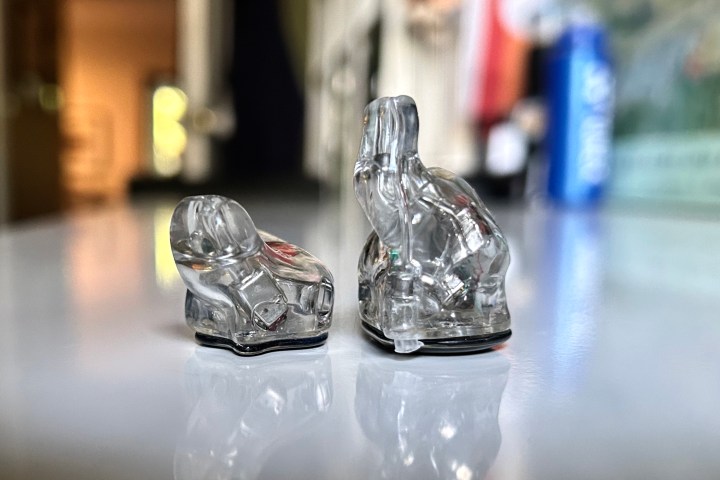
Do these look oddly shaped? (Thanks, those are my ears you’re judging.) The long, slightly bent section of the Premier is the tip that extends into your ear canal.
Some custom IEMs use a shorter tip that only snugs up against the first curve of an ear canal (e.g., the UE 5 Pro pictured above), which feels just a wee bit more intimate than a standard set of silicone-tipped earbuds. The best part is that there’s no pressure — they just fill your conchas completely. However, they can still become dislodged with aggressive jaw movement as your ear naturally flexes in response.
The Premier go past that first curve, all the way to the second curve. It’s very intimate. If the custom molding process has been a success, you should still feel no pressure, but the real benefit is for singers: open your mouth as wide as you like and scream until you’re hoarse — the Premier aren’t going anywhere. The shape also is a necessity for the Premier’s acoustic architecture; it allows the sound tubes to be a specific length, which helps to give them their sound signature.

The notion of a product that has been custom fit to the exact contours of your body is inherently desirable. A bespoke suit from Savile Row is the height of sartorial indulgence, and every Formula 1 driver gets a steering wheel that has been molded to the size and shape of their hands, and a seat molded to that end, too. And yet, a set of earbuds that feel like someone has poured molten plastic into your ears takes some getting used to.
Don’t be surprised if you don’t love it at first. I’ve been using the Premiers for more than six weeks and they still feel weird. It’s the so-called occlusion effect — that sense of having your ears plugged — that is especially strong with the Premiers.
As you might expect, it’s the portion of the tip that sits deepest in the canal that requires the most acclimation. Because the shape is so closely contoured to your canal, there’s only one position that won’t cause discomfort, something I found out the hard way. But once you’ve located that sweet spot, they are very comfortable, and much to my surprise, they don’t cause the same amount of fatigue or itch as conventional IEM designs.
If you just can’t get comfortable, UE Pro will allow for up to two rounds of adjustments, using your feedback on which part of the IEM is causing problems. If that doesn’t work, they’ll create a new set from scratch, without charging you anything more.
- 1. The tiny ambient plugs come attached to larger plastic posts, but these are discarded after you remove the plugs.
One of the best parts of having a set of earbuds that are so perfectly shaped to your ear is that external noise is hardly ever a concern, especially when you insert the plugs into the ambient ports. But those plugs are a pain in the ass. They’re tiny, they are hard to push into the ports (you can see in the photo above that I wasn’t successful in fully seating one of them), and if you don’t cram them in just right, they pop out again all too easily. Good luck finding a 3mm clear piece of silicone on your carpet. If you take them out, you’ll need a place to store them.
Moreover, the additional sound they let in is only useful in a genuine live-performance situation. The unplugged ports won’t act as a replacement for the transparency mode you find on wireless earbuds. Yes, you hear a bit more of the world around you, but it’s not a useful amount on day-to-day basis, and it comes at the price of reduced low-end frequency response. Unless you’re a music pro who could really benefit from that stage bleed, save yourself the $50.
UE Premier: 21 drivers

Why so many drivers? Isn’t 21 just a tad excessive, especially when the oBravo Ra-c-cu, (which at $12,729 are the most expensive IEMs in the world) use just two drivers? It’s all about frequency response and clarity. UE Pro has chosen to go with balanced armature (BA) drivers over competing technologies like dynamic drivers, planar magnetic, and air motion transformer (AMT) because BA drivers are tiny and they can be tuned to very specific frequency ranges.
They’re managed via a set of five crossovers — tiny electrical devices that divvy up a single audio signal into dedicated signals for each frequency range that’s being targeted. So while there may be 21 drivers, there are only five distinct frequency ranges.

Here’s how those 21 BA drivers are arranged inside the Premier:
- Two dual sub-low frequency (four BA drivers)
- Two groups of two dual diaphragm mid-low frequency (eight BA drivers)
- One quad mid frequency (four BA drivers)
- One True Tone Plus (one BA driver)
- One quad high super tweeter (four BA drivers)
Some of those drivers aren’t able to push enough air on their own, so they have been grouped into sets of two or four identical units (e.g., the four sets of dual diaphragm mid-low drivers), which multiplies their power.
When you take them all together, their breadth is huge. From a low of just 5Hz to a high of 40kHz, in theory, there’s no human-audible frequency they can’t reproduce.
UE Premier: sound quality

The result is astonishing. With the ambient plugs installed, I can safely say I have never heard anything like the UE Premier. The sheer amount of detail these IEMs can render makes lesser earbuds sound two-dimensional by comparison. And I’m not talking about the kind of garden-variety IEMs you can buy on Amazon for $50 to $75. I put the Premier up against models varying in price from $500 to $1,500, including the custom-fit UE 5 Pro ($549), Meze Audio Advar ($699), Audeze Euclid ($1,299), and custom-fit Campfire Audio Supermoon ($1,500).
Tonally, the Premier sound balanced to me, with no particular emphasis on any one frequency range. Ordinarily, a balanced or neutral EQ translates as dull or flat to my ears, and often lacking in low-end. I did not love the UE 5 Pro because of this — but the Premier are lively, with no detectable holes, and no missing bass. Without any measurement equipment to confirm it, I suspect the Premier’s five crossovers and multiple drivers make all the difference here.

Clarity across the frequency spectrum is excellent. Within any given song, each instrument and vocalist stood apart. If you want to place your focus on a single element — like the vocals or a bass line — doing so is effortless. The Premier are a high-powered magnifying glass, letting you zoom in on the details.
But that precision is more than just a separation of frequencies. It also maps those elements across the soundstage with astonishing accuracy. The sphere of sound extends from just in front of your face to several feet away in all directions. That depth becomes really noticeable as you listen to Emily Wolfe’s White Collar Whiskey. The reverb on her guitar and the echo on her vocals decay into space like ripples on a pond’s surface.
It’s not uncommon for audiophiles to praise a set of speakers, headphones, or IEMs for their ability to let them hear details in their favorite tracks that were previously unavailable — and this has definitely been my experience with the Premier. One particularly gratifying moment came while listening to Stevie Ray Vaughan’s Tin Pan Alley, a track I’ve now heard more times than I care to count. As Vaughan does his signature guitar work, I was able to hear the lowest notes propagate to the left, while higher notes careened to the right. That little bit of spatial detail has presumably been there all along, and I’d never noticed it. It made me hit Google in search of photos of the recording session so that I could see how the engineers had placed the mics in the studio. Alas, no such luck.
Are the UE Premier perfect? No. Transients like snare and cymbal hits can feel a bit mushy at times. Going back and forth between the Premier and the Campfire Audio Supermoon on a track like the Red Hot Chili Peppers’ Higher Ground reveals how the Supermoon’s planar magentics drivers deliver a more taut, energetic reproduction of the percussion. The same comparison also shows that the Premier’s remarkable soundstage can have the unintended consequence of creating too much space in the overall sound, which can diminish cohesiveness. This effect was more noticeable on some recordings than others. Don Henley’s Boys of Summer, for instance had a lot, while Tracy Chapman’s Fast Car had almost none.
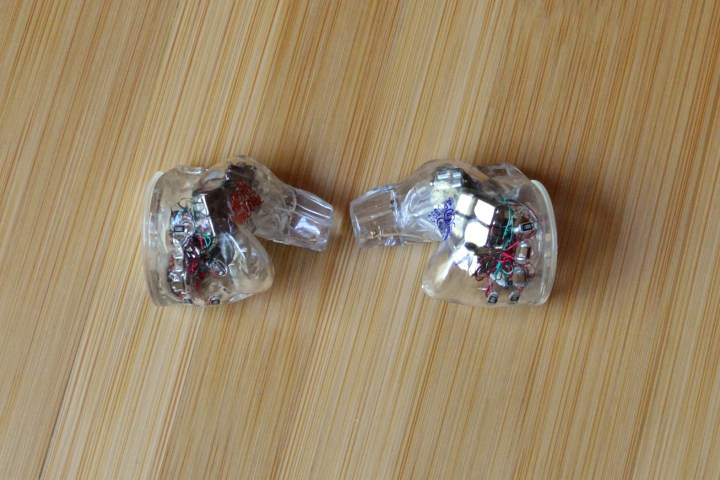
There is, however, a very big caveat to using a set of IEMs like the Premier. Because of their ability to reproduce sound at an almost clinical level of accuracy, you may realize that the rest of your gear — and maybe your music sources — aren’t as good as you thought.
Sticking with the magnifying glass analogy from above, seen from several feet away, a painting and a photo of the painting might look similar. If you were to look closely at the painting, you’d be able to appreciate all of the subtle details in each brush stroke, but a similar inspection of the photo would likely only reveal the dots of ink that make up the photo. The same is true for music. The UE Premier will apply their precision to all material equally, and that could mean you’ll become aware of flaws that were previously inaudible.
There’s a great instrumental track called Darkstar by two notable movie music composers, Harold Faltermeyer and Hans Zimmer, plus Lady Gaga and Lorne Balfe, from the Top Gun: Maverick soundtrack. In the movie, it serves as the exciting backdrop as Maverick and his team get ready for an audacious Mach 9.1 test flight. But the version you can stream from Apple Music, Tidal, and others is a mess. All of the elements in the complex orchestral piece sound like they’ve been mashed together and flattened. The energy is still there, but it’s just not enjoyable to listen to. While I was vaguely aware of this when listening via my home theater system, it became unavoidable when I popped in the Premiers.
I’m fortunate enough to have no fewer than eight headphone DAC/amps on hand. And while I’ve been able to hear moderate differences between them while testing other IEMs and headphones, this was the first time I noticed the profound ways in which they can affect a sound signature.
My go-to DAC/amp is the Ifi Go Bar, a well-regarded device with high-end components. It had no problem driving the Premier. In fact, with an impedance of just 15 ohms and sensitivity of 126 dB at 1 kHz, you’ll have no problems driving them with any audio device. The Go Bar has tons of power — more power than I could ever comfortably endure — but it also created an unpleasant bloated quality to some sounds, while causing an almost hollow effect with others.
On Dire Straits’ You And Your Friend, Mark Knopfler’s guitar sounds blown out, like it’s being piped through a megaphone. It doesn’t sound distorted, but all of the fine edges have been sanded off, leaving a shapeless blob. And Nick Cave’s gravelly vocals in Red Right Hand became muddy, losing much of their sinister tones.
I ended up switching to the Astell & Kern USB-C Dual DAC Cable, a device I’ve shied away from in the past due to its lack of iOS compatibility (the newer version fixes that). The Dual DAC Cable produces less power than the Go Bar, but it’s a far better match for the Premier and it effectively eliminated the problems I experienced with the Go Bar.
It’s difficult to say whether the UE Premier are worth the $3,000 asking price. Sadly, I can’t answer that question at all from a live performer’s perspective. But if you take great pleasure from sitting down and spending hours immersing yourself in your music — literally with eyes closed and your entire being focused on extracting every detail from a chosen track — I suspect that the UE Premier will reveal those details to you better than almost any other IEM you’ve tried so far.
Likewise, if you’re an audio engineer or producer looking to supplement your in-studio monitors or headphones with another critical listening tool, I can see the Premier filling that role really well.
But for anyone else, the UE Premier are overkill, and your Spotify playlist might actually sound worse, not better.
Editors' Recommendations
- 1More’s new wired earbuds pack five drivers and planar tech for $170
- The UE Drops are the first truly custom-fit wireless earbuds you can buy



